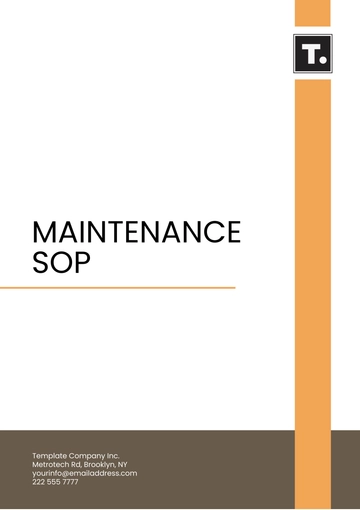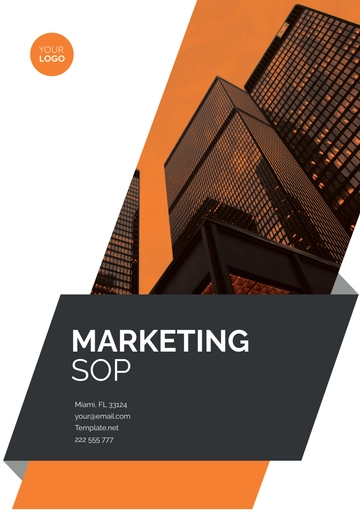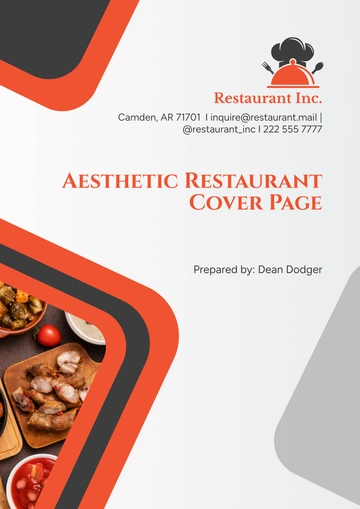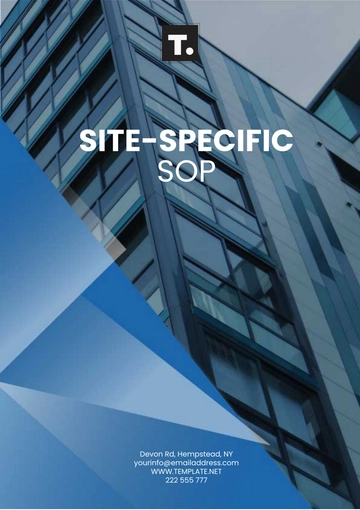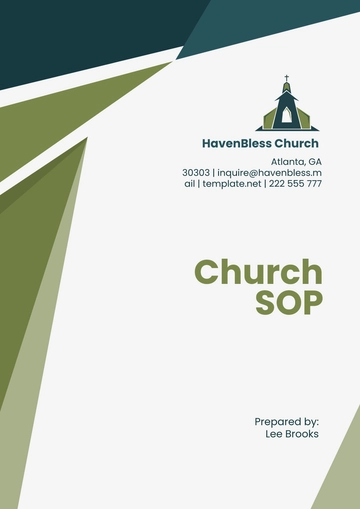Free Spa Business SOP

I. Introduction
This Standard Operating Procedure (SOP) document serves as a comprehensive guide for the daily operations within [Your Company Name] spa. Its goal is to ensure consistency, quality, and efficiency in service delivery, adhering to the highest standards of client satisfaction.
A. Purpose
The purpose of this SOP is to streamline the operational processes of [Your Company Name], provide clear guidelines for staff responsibilities, and maintain a high standard of service.
B. Scope
This SOP applies to all staff members within the spa, including therapists, receptionists, and support staff.
II. Operational Guidelines
Ensuring the spa operates smoothly and efficiently requires adherence to detailed operational guidelines. This chapter provides an expanded overview of the essential procedures to follow during opening, client check-in, service delivery, and closing to maintain high standards and client satisfaction.
A. Opening Procedures
Arrival
Staff Arrival Time:
All staff should arrive at the spa by [Opening Time].
Punctuality is crucial to ensure that the spa is prepared and ready to welcome clients promptly. Being on time helps maintain a professional image and allows for adequate preparation before opening.
Initial Setup
Activating Equipment:
Turn on all necessary equipment, including treatment devices, lights, and computers.
Ensuring all equipment is functional at the start of the day minimizes disruptions during operations.
Ambiance Creation:
Start music and aromatherapy diffusers to create a calming and inviting atmosphere.
A welcoming ambiance sets the tone for a relaxing spa experience and enhances client satisfaction from the moment they enter.
Walkthrough
Facility Inspection:
Conduct a thorough walkthrough of the spa, checking all areas such as treatment rooms, reception, restrooms, and common areas for cleanliness and order.
Address any cleanliness or maintenance issues immediately to ensure a pristine environment.
Maintenance Checks:
Ensure that all light fixtures, plumbing, and HVAC systems are in working order. Report any issues to the maintenance team for prompt resolution.
Stocking Supplies
Supply Check:
Verify that all treatment rooms are stocked with necessary supplies, including fresh linens, towels, oils, creams, and other products.
Ensure all products are properly labeled and stored to prevent confusion and maintain hygiene standards.
Inventory Management:
Regularly update inventory records to track the usage of supplies and avoid shortages. Implement a system for staff to report low stock levels promptly.
Schedule Review
Daily Schedule:
Review the day's schedule, noting any special client requests, appointments, and preferences.
Communicate specific instructions to relevant staff members to ensure personalized and attentive service.
Briefing Staff:
Hold a brief team meeting to discuss the day's schedule, highlight any special client needs, and address any questions or concerns from staff.
B. Client Check-In
Client check-in is the first point of contact and sets the stage for the client’s experience. Ensuring a seamless and welcoming check-in process is vital for client satisfaction.
Greeting Clients
Warm Welcome:
Greet clients warmly upon entry with a friendly and professional demeanor.
Make eye contact, smile, and use the client’s name when possible to create a personal connection.
First Impressions:
The reception area should always be clean, organized, and inviting. Ensure magazines, brochures, and other materials are neatly arranged.
Appointment Verification
Confirming Appointments:
Verify client appointments in the scheduling system promptly.
Confirm any special requests or notes associated with the appointment to ensure tailored service.
Handling Walk-Ins:
For walk-in clients, check availability and inform them of any wait times. Offer alternatives if immediate service is not possible.
Registration Form
Collecting Information:
Provide clients with a registration form to fill out, including sections for health information, preferences, and contact details.
Ensure forms are completed accurately and stored securely in compliance with data protection regulations.
Confidentiality:
Maintain strict confidentiality of client information. Store physical forms in locked cabinets and use secure digital systems for electronic records.
Refreshments and Waiting Area
Offering Refreshments:
Offer clients refreshments such as water, tea, or coffee while they wait.
Ensure a variety of options are available, including herbal teas and filtered water.
Comfortable Waiting:
Direct clients to the waiting area, ensuring it is comfortable, clean, and welcoming.
Provide reading materials, soothing music, and comfortable seating to enhance the waiting experience.
III. Service Delivery
Delivering exceptional service is at the core of [Your Company Name] spa’s operations. This section outlines the steps to ensure treatments are prepared, delivered, and concluded to the highest standards.
A. Treatment Preparation
Client Records
Reviewing History:
Review client records and preferences before starting any treatment.
Ensure any special needs, allergies, or contraindications are noted and addressed.
Personalized Service:
Use the information from client records to personalize the treatment and enhance the client experience.
Treatment Room Setup
Room Preparation:
Prepare treatment rooms with fresh linens and sterilized equipment.
Arrange the room to create a serene and inviting atmosphere, with attention to details such as lighting and music.
Product Availability:
Ensure all products and tools required for the scheduled treatments are readily available.
Check that all products are within their expiration dates and replace any that are not.
B. Treatment Procedures
Client Welcome
Introduction:
Welcome the client to the treatment room and discuss today’s treatment plan.
Answer any questions the client may have about the treatment and ensure they feel comfortable and informed.
Client Consultation:
Conduct a brief consultation to confirm any last-minute preferences or concerns. Adjust the treatment plan accordingly.
Ensuring Comfort
Comfort Measures:
Ensure client comfort, privacy, and relaxation throughout the treatment.
Adjust the room temperature, lighting, and music according to client preferences.
Client Feedback:
Encourage clients to provide feedback during the treatment. Make adjustments as necessary to enhance their comfort.
Following Protocols
Treatment Steps:
Follow the specific steps and protocols for each treatment offered, maintaining consistency and quality.
Use only approved products and techniques to ensure client safety and satisfaction.
Professional Conduct:
Maintain a high standard of hygiene and professionalism at all times. Wear appropriate attire and practice good personal hygiene.
Monitoring Responses
Client Reactions:
Monitor client responses and adjust treatments as necessary to ensure comfort and effectiveness.
Be attentive to verbal and non-verbal cues to gauge client satisfaction.
Adjustments:
Make real-time adjustments to the treatment based on client feedback and responses. Ensure any changes are documented for future reference.
C. Post-Treatment Protocol
Aftercare Recommendations
Providing Advice:
Provide aftercare recommendations to the client, including any products that can be purchased for home use.
Offer advice on how to maintain the benefits of the treatment between visits.
Product Sales:
Recommend products that complement the treatment and address specific client needs. Offer samples if available.
Escort to Reception
Client Escort:
Escort the client back to the reception area, ensuring they feel valued and cared for.
Thank the client for their visit and encourage them to provide feedback on their experience.
Documentation
Treatment Records:
Document the treatment in the client's record, noting any important observations or feedback.
Update the CRM system to reflect the client's experience and any recommendations for future visits.
Confidentiality:
Ensure all documentation is handled confidentially and stored securely.
Room Reset
Room Cleaning:
Prepare the treatment room for the next client, ensuring it is clean and fully stocked.
Replace linens, sterilize equipment, and reset the room to maintain a consistent standard of cleanliness.
Stock Check:
Check and replenish supplies as needed. Report any low stock levels to the Spa Manager.
IV. Closing Procedures
Closing procedures are essential to ensure the spa is secure, clean, and ready for the next day’s operations. This section outlines the steps to effectively close the spa.
A. Client Check-Out
Processing Payments:
Ensure all clients have checked out and any payments have been processed accurately.
Confirm that clients are provided with receipts and any follow-up information.
Rebooking:
Offer clients the opportunity to book their next appointment, providing information on any upcoming promotions or special offers.
B. Equipment and Lights
Shutting Down:
Turn off all equipment and lights, ensuring energy efficiency and safety.
Double-check that all devices are properly shut down and any hazards are mitigated.
C. Final Walkthrough
Cleanliness Check:
Perform a final walkthrough to check for cleanliness and straightening up.
Ensure that all areas, including treatment rooms and common areas, are tidy and ready for the next day.
Maintenance Issues:
Address any immediate maintenance issues. Report any larger concerns to the maintenance team for prompt attention.
D. Securing Supplies
Securing Valuables:
Secure all supplies and ensure all rooms are locked.
Verify that all valuable items are safely stored and any sensitive materials are secured.
E. Schedule Review
Next Day Preparation:
Review and confirm the schedule for the next day, ensuring all appointments and staff assignments are correct.
Communicate any special instructions or changes to relevant staff members to ensure a smooth start to the next day’s operations.
V. Emergency Protocols
Emergencies require prompt and effective action to ensure the safety and well-being of clients and staff. This section provides guidelines for handling medical and facility emergencies.
A. Medical Emergencies
Assessing the Situation
Stay Calm:
Stay calm and assess the situation quickly to determine the severity of the emergency and the appropriate response.
Immediate Action:
Take immediate action to stabilize the situation while awaiting professional medical assistance.
Calling Emergency Services
Emergency Contact:
Call emergency services immediately if needed.
Provide clear and concise information about the emergency, including location and nature of the incident.
First Aid
Initial Response:
Provide first aid within the scope of your training while waiting for help.
Use the spa's first aid kit and follow standard first aid procedures.
Training:
Ensure all staff are trained in basic first aid and CPR. Regularly review and update training as necessary.
Incident Documentation
Recording Details:
Document the incident thoroughly and report it to management as soon as possible.
Ensure all details are recorded accurately for future reference and any necessary follow-up actions.
B. Facility Emergencies
Reporting Issues
Immediate Reporting:
Report any facility issues, such as power outages or water leaks, to management immediately.
Use established channels for quick communication to ensure prompt action.
Emergency Evacuation
Evacuation Plan:
Follow the emergency evacuation plan if necessary.
Ensure the safety of clients and staff during the emergency, assisting those who need help.
Regular Drills:
Conduct regular evacuation drills to ensure all staff are familiar with procedures and can act quickly in an emergency.
VI. Staff Roles and Responsibilities
To ensure the smooth operation of [Your Company Name] spa, it is essential to define and adhere to the roles and responsibilities of each staff member. This section provides a detailed outline of the duties of the Spa Manager, Therapists, and Receptionists.
A. Spa Manager
The Spa Manager plays a critical role in overseeing the daily operations and ensuring the highest standards of service and efficiency.
Daily Operations
Overseeing Operations:
The Spa Manager is responsible for the overall management of daily operations, ensuring that all activities align with the established SOPs.
This includes monitoring staff performance, ensuring timely service delivery, and maintaining a productive work environment.
Staff Scheduling:
Create and manage staff schedules to ensure adequate coverage for all shifts and services.
Adjust schedules as needed to accommodate client demand and staff availability.
Client Appointments:
Oversee the appointment booking system to ensure accuracy and efficiency.
Handle any issues related to scheduling conflicts or special client requests.
Client Relations
Complaint Resolution:
Handle client complaints and feedback promptly and professionally, ensuring timely and satisfactory resolutions.
Implement feedback mechanisms to continuously improve service quality.
Enhancing Satisfaction:
Foster positive client relationships through personalized interactions and follow-up communications.
Develop and implement strategies to enhance overall client satisfaction and loyalty.
Inventory Management
Supply Management:
Ensure the spa is well-stocked with necessary supplies, including treatment products, linens, and office supplies.
Conduct regular inventory checks to monitor stock levels and place orders as needed.
Vendor Relations:
Maintain relationships with suppliers and negotiate contracts to secure the best prices and quality for products and supplies.
B. Therapists
Therapists are essential for delivering high-quality treatments and ensuring client satisfaction.
Service Delivery
Performing Treatments:
Perform treatments according to client requests and company standards, ensuring a consistent and high-quality service experience.
Stay updated on new treatment techniques and industry trends to offer the best possible care.
Professionalism and Care:
Maintain a high level of professionalism in all client interactions.
Ensure that each client feels valued and cared for throughout their visit.
Record Keeping
Accurate Documentation:
Maintain accurate and up-to-date client records, including treatment details and any specific client preferences or concerns.
Use the CRM system to document client interactions and feedback.
Confidentiality:
Ensure the confidentiality of all client information, adhering to data protection regulations and company policies.
Treatment Room Maintenance
Room Preparation:
Ensure treatment rooms are clean, organized, and fully stocked before each appointment.
Sterilize equipment and replace linens after each client to maintain hygiene standards.
Maintenance Reporting:
Report any maintenance issues or equipment malfunctions to the Spa Manager promptly to ensure quick resolution.
C. Receptionists
Receptionists are the first point of contact for clients and play a vital role in managing client interactions and administrative tasks.
Client Interaction
Greeting and Check-In:
Greet clients warmly upon arrival, manage check-ins, and provide registration forms.
Ensure a welcoming and professional demeanor at all times.
Scheduling and Inquiries:
Handle appointment scheduling and client inquiries efficiently and accurately.
Provide clients with information about services, promotions, and any special offers.
Payment Processing
Transaction Handling:
Process payments accurately, ensuring that all transactions are recorded correctly.
Maintain financial records and ensure all transactions are handled securely.
Financial Reconciliation:
Reconcile daily financial transactions and prepare reports for management review.
VII. Training and Compliance
Ongoing training and strict adherence to compliance standards are crucial for maintaining the quality and safety of spa services.
Initial Training
Comprehensive Training:
All new staff members must participate in initial training sessions covering spa procedures, customer service, and health and safety regulations.
Ensure that each employee has a thorough understanding of their role and responsibilities before they begin working independently.
Ongoing Training
Regular Updates:
Staff must engage in ongoing training to stay updated on new procedures, products, and industry trends.
Provide regular workshops and refresher courses to enhance skills and knowledge.
Professional Development:
Encourage staff to pursue professional development opportunities, such as certifications and advanced training programs, to further their expertise.
Compliance
Health and Safety:
Adhere to all health and safety regulations as mandated by law, including proper sanitation practices and emergency protocols.
Conduct regular audits to ensure compliance with these standards.
Regulatory Updates:
Regularly review and update practices to ensure ongoing compliance with any new regulations or industry standards.
VIII. Review and Updates
Regular review and updates of the SOP document ensure that the spa's operations remain efficient and compliant with current standards.
Annual Review
Comprehensive Review:
This SOP document will be reviewed and updated annually to reflect any changes in procedures, regulations, or industry standards.
Involve staff in the review process to ensure that the updates are comprehensive and practical.
Feedback Integration:
Collect feedback from staff and clients throughout the year to identify areas for improvement. Incorporate this feedback into the annual review.
Notification of Changes
Staff Communication:
Notify all staff members of any changes to the SOP promptly.
Provide updated SOP documents and conduct training sessions to explain the changes and ensure understanding.
Implementation:
Implement any changes smoothly to avoid disruptions in operations. Monitor the transition to new procedures to ensure they are followed correctly and effectively.
IX. Acknowledgment
By signing below, staff members acknowledge that they have read, understood, and agree to comply with the Standard Operating Procedures outlined in this document.
Signature:

[Staff Name]
[Date]
- 100% Customizable, free editor
- Access 1 Million+ Templates, photo’s & graphics
- Download or share as a template
- Click and replace photos, graphics, text, backgrounds
- Resize, crop, AI write & more
- Access advanced editor
Elevate your spa business with Template.net's Spa Business SOP (Standard Operating Procedure) Template. Effortlessly customize procedures for every aspect of your spa, from client check-in to treatment protocols and staff responsibilities, using our intuitive AI editor tool. Ensure efficiency and consistency with our comprehensive SOP template, tailored to your spa's specific needs and easily updated as your business evolves.




